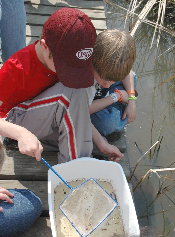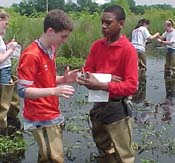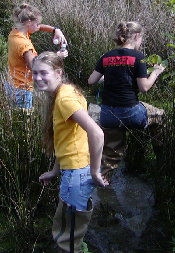|
|
|
Student Use
|
|
|
| We have mapped out a curriculum which would allow students at all levels to be exposed to wetland related activities. |
|
|
 |
|
|
| Lower School: We have a place-based "young naturalist" program to develop awareness of living things, to learn observation & to make records. Activities include visiting the wetland in different seasons, learning some indicator species, using samples collected on field trips to make classroom "wetland" aquaria for observation, learning the relationship between land and water (sponge effect, watersheds), learning about seed types and dispersal mechanisms. |
|
|
|
 |
|
|
|
Middle School: Activities are integrated into the Science curriculum and include simple water chemistry (temperature, turbidity, pH), soil temperature and biomass, plant identification & use of a dichotomous key, mapping plants in specific areas, examination of water for small & microscopic organisms, relationship of wetland to ecosystems.
|
|
|
 |
|
|
|
| High school: The Environmental Sciences classes determine ecosystem variation across a water gradient by sampling plants along transects leading from the edge to the interior of the wetland, study soil & water chemistry, investigate insect biodiversity. Wetland samples are used when studying soil bacteria & algae in the Microbiology class. Students in the Independent Studies class have worked on many projects including, snail chemotaxis, capture of prey by fishing spiders, adaptations of roots to hydric soil, mapping in relation to topography & vegetation, constructing field guides, and study of medicinal and edible plants in the wetland area. |
|
|
|
|
|
|
|
|
|
|
|